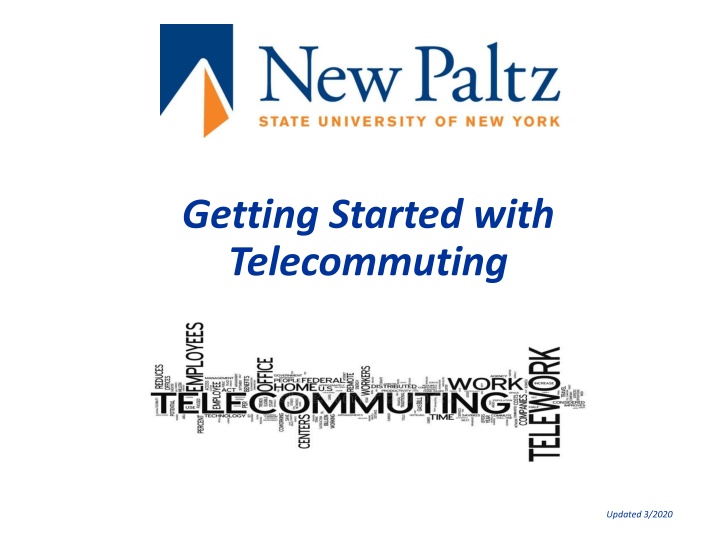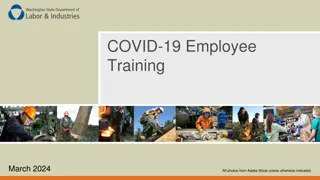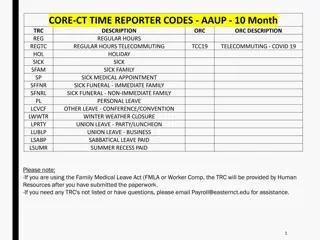Telecommuting During Covid-19: Guidelines & Strategies
This comprehensive slide deck addresses telecommuting during the Covid-19 health crisis, offering strategies for managing temporary work arrangements and alternate work locations. It covers key definitions, setting up work tools and space, program guidelines, staying connected, and more. The telecommuting agreement reached in March 2020 by GOER and various bargaining units is also discussed. Access resources and training agenda for successful telecommuting.
Download Presentation

Please find below an Image/Link to download the presentation.
The content on the website is provided AS IS for your information and personal use only. It may not be sold, licensed, or shared on other websites without obtaining consent from the author.If you encounter any issues during the download, it is possible that the publisher has removed the file from their server.
You are allowed to download the files provided on this website for personal or commercial use, subject to the condition that they are used lawfully. All files are the property of their respective owners.
The content on the website is provided AS IS for your information and personal use only. It may not be sold, licensed, or shared on other websites without obtaining consent from the author.
E N D
Presentation Transcript
Getting Started with Telecommuting Updated 3/2020
Context This slide deck was developed specifically to address telecommuting during the Covid-19 health crises and provides strategies and guideline for managing temporary work arrangements and alternate work locations. Please remember that not all work is eligible or appropriate for telecommuting. The determination is made based on the business needs of the college. Resources for implementing telecommuting assignments may be limited and should be considered carefully in planning.
Training Agenda Telecommuting Agreement (GOER) Key Definitions of Agreement Setting up Your Work Tools for Telecommuting Setting Up Your Space Important Reminders Key Program Guidelines Staying Connected Resources for Telecommuting
Telecommuting Agreement March 16, 2020 : GOER (Governor s Office of Employee Relations) reaches an agreement with M/C, UUP, PEF and CSEA bargaining units on a telecommuting pilot program for employees . The purpose and spirit of this pilot program: To support employees balance work and life demands, such as child care, during this health crisis. To reduce the density of employees in the workplace, foster social distancing and hopefully slow the opportunity for spreading of the virus. We will review key terms and provisions. The full agreement is available here: http://d31hzlhk6di2h5.cloudfront.net/20200316/a7/96/c4/69/12e91235cb63 e1dbaea9922e/200316_Telecommuting_Bulletin_GOER._all_bargaining_units __1_.pdf
Key Definitions Telecommuting is an alternative work arrangement that allows employees to conduct some or all of their work away from the official work location. Official Work Site is the employee s State-approved work station at their customary work address Alternate Work Site is a location where the employee is authorized to conduct business that has been approved by their supervisor and meet the guidelines mapped out in the policy. Set Schedule are the required customary hours and days work in a pay period. Telecommuting Work Plan is a document completed by the telecommuter that provides details about hours and work performed.
Program Process Divisional Leader Review Work Plan Confirmed Begin Apply Telecommuting Telecommuting Training Manager Review HRDI Review You can access the application here: http://d31hzlhk6di2h5.cloudfront.net/20200316/a7/96/c4/69/12e91235cb63e1dbae a9922e/200316_Telecommuting_Bulletin_GOER._all_bargaining_units__1_.pdf
Setting Up Your Work Before you can begin telecommuting it is important to understand the work expectations and what might be different when working at an alternative site. Keep in mind telecommuters should treat telecommuting days like regular work days and will be expected to maintain a regular work routine. You will need to work with your manager to develop a work plan that meets operational needs and outlines clear expectations about your work.
Establishing a Work Plan Prior to telecommuting, you will need to work with your supervisor to establish a work plan. The workplan should include: What work will be undertaken remotely Hours you will be working remotely and where/when on-site presence may be required. How to reach you Timelines for work deliverables Resources for support A regular communication schedule with your manager and colleagues Please be aware that telecommuting plans might need to evolve based on changing business needs.
Tools for Telecommuting Our campus offers valuable resources for teams to be able to incorporate remote work into their business functions. These include: Single-Sign On Access to Software Webex Conferencing and Phone Calls Microsoft Teams Conference Line One-Drive for storing and sharing files Office 10 upgrades for home computers LinkedIn Learning for on demand training Please be aware that remote access to campus systems including the campus drives and your personal drives will be limited to those who have the most pressing business need.
Setting Up Your Space You will need to be able to provide your own phone and a suitable level of internet service to telecommute. Please be aware you will not be reimbursed for this. Some employees may need to use College issued devices given the nature of their work and the systems they need to access. Others will need to use their own devices. Supervisors should be sure to address this in off-site plans. Identify a location to store your college issued devices and any documents you may require for your work. You are responsible for adhering to all information security and confidentiality policies when working remotely. No in-person meetings at your alternative location are permitted but you will be asked to participate in web based or phone conference calls as needed. TIP: Best practices recommend having a dedicated regular work space to help create psychological separation between your work time and your home life.
Important Reminders All attendance rules and call-in processes apply for telecommuting employees, but additional procedures could be mapped out in the work plan. Telecommuting is not operationally feasible for all job functions. The College determines which job functions are eligible to participate in telecommuting. Managers may require telecommuters to have a set telecommuting schedule. Email will take the place of many in-person communications. Your tone can easily be lost on email. Consider picking up the phone or scheduling a virtual meeting for sensitive or complex conversations.
Key Program Guidelines Employees can apply to participate in telecommuting or be mandated by their employer to participate. Employees must comply with all NYS and agency laws, rules and policies for the official work site when telecommuting. All assigned duties will be performed in a manner consistent with college rules, policies, practices, collective bargaining agreements and ethical standards. Elements of the work plan can be flexible but must align with or support the employees regular obligation.
Staying Connected For many of us, our work provides social connection and community. It is important to be intentional about planning for how you will stay connected to your manager and colleagues while working remotely. Where possible maintain your participation in regular meeting schedules but through a virtual format. Have department meetings or agreed upon update schedules to ensure that everyone stays informed about how the situation is impacting the concerns of your unit in particular. Start or participate in an office email chain sharing (work appropriate) fun facts or inspirational quotes to help foster a positive connection to those you work with.
Best Practices Telecommuting is both a professional skill and a new habit. It can be challenging to learn new things and transition to new patterns. When in doubt Be clear with your supervisor about what life needs need to be considered so that the right plan can be identified or adjusted accordingly. Over communicate- changes in routines mean we need to be clearer in communication. Be mindful of tone and email etiquette-everyone is adjusting! Be responsive and respectful of others time. Be patient with yourself and others. Establish a consistent time to eat- this can easily be lost when learning to telecommute. Take a brief walk, stretch or meditate- it helps improve concentration and productivity to change scenery or mindset for a few moments. If others are in your alternate worksite ensure they understand when you are in work mode . Be consistent with and protective of that time. Access available training to help you improve or learn new ways of doing work.
Helpful Resources Quick Start Guide for Webex https://www.youtube.com/watch?v=60lX_A3Inqo Common Challenges of Working Remotely https://www.themuse.com/advice/remote-work-challenges LinkedIn Learning Recommended Courses: Time Management: Working from Home (1.5 hours) Working Remotely (1 hour)























